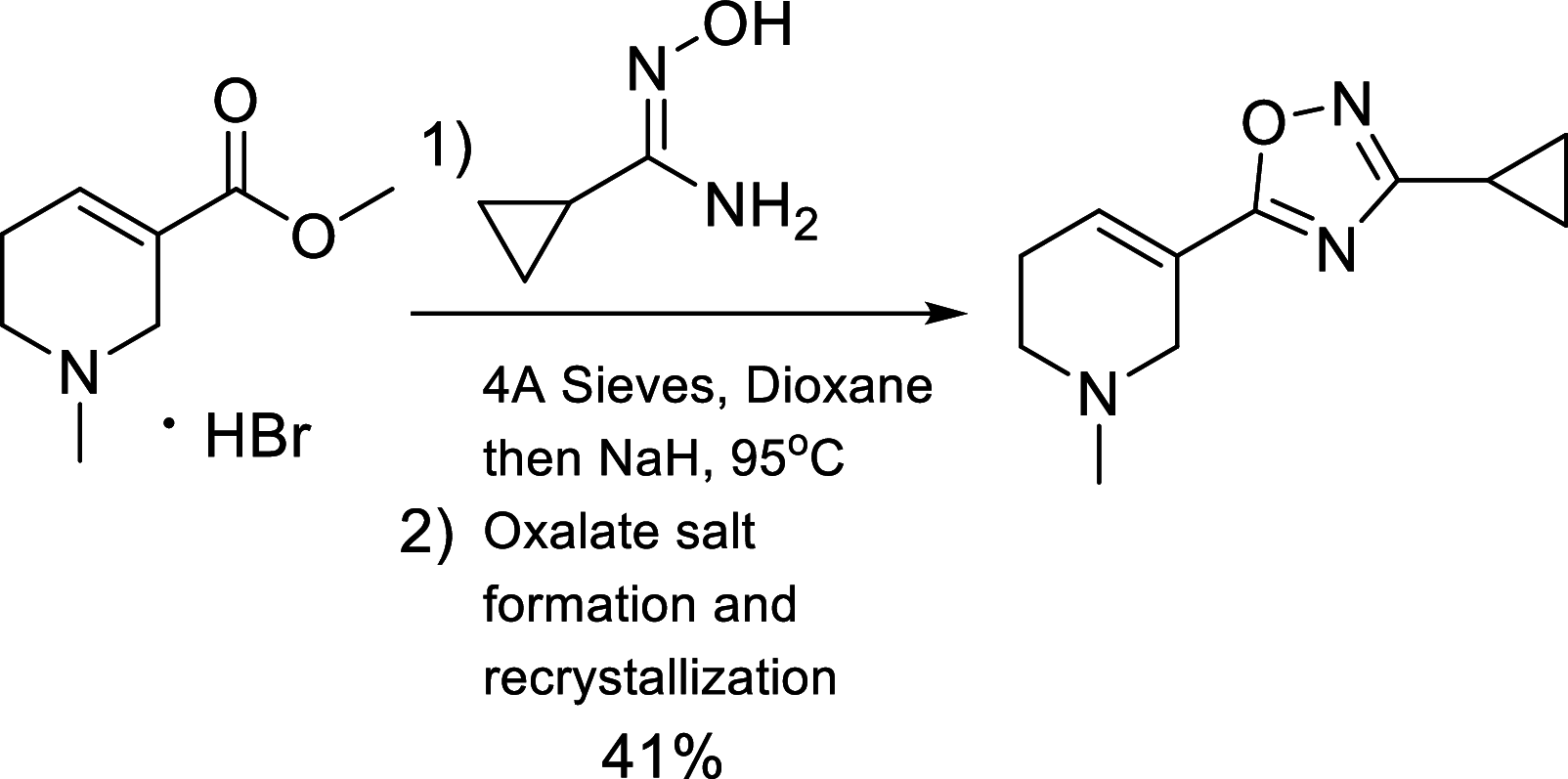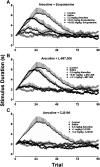Novel Antimuscarinic Antidepressant-like Compounds with Reduced Effects on Cognition
- PMID: 33712507
- PMCID: PMC8140394
- DOI: 10.1124/jpet.120.000337
Novel Antimuscarinic Antidepressant-like Compounds with Reduced Effects on Cognition
Abstract
The cholinergic nervous system has been implicated in mood disorders, evident in the fast-onset antidepressant effects of scopolamine, a potent muscarinic antagonist, in clinical studies. One prominent disadvantage of the use of scopolamine in the treatment of depression is its detrimental effects on cognition, especially as such effects might aggravate cognitive deficits that occur with depression itself. Thus, the identification of antimuscarinic drugs that are free of such detrimental effects may provide an important avenue for the development of novel therapeutics for the management of depression. The present data in rats indicate that a historical muscarinic antagonist, L-687,306, and a muscarinic antagonist of our own design, CJ2100, were as or more effective than scopolamine in antagonizing both the bradycardic effects of the muscarinic agonist arecoline in cardiovascular studies and its discriminative stimulus and rate-decreasing effects in behavioral studies. Additionally, both novel muscarinic antagonists were as effective as scopolamine in decreasing immobility in the forced swim test, a preclinical indicator of potential antidepressant activity. However, at equieffective or even larger doses, they were considerably less disruptive than scopolamine in assays of cognition-related behavior. All three drugs displayed high specificity for the mAChRs with few off-target binding sites, and CJ2100 showed modest affinity across the mAChRs when compared with L-687,306 and scopolamine. These data emphasize the dissimilar pharmacological profiles that are evident across antimuscarinic compounds and the potential utility of novel antagonists for the improved treatment of depression. SIGNIFICANCE STATEMENT: Some clinical studies with the muscarinic antagonist scopolamine document its ability to produce antidepressant effects in patients with mood disorders; however, scopolamine also has well known adverse effects on both autonomic and centrally mediated physiological functions that limit its therapeutic use. This study characterizes the cardiovascular and discriminative stimulus effects of two novel muscarinic antagonists, L-687,306 and CJ2100, that produce antidepressant-like effects in a rodent model (forced swim test) without affecting touchscreen-based cognitive performance (titrating psychomotor vigilance and delayed matching-to-position).
Copyright © 2021 by The American Society for Pharmacology and Experimental Therapeutics.
Conflict of interest statement
The authors are coholders of a pending United States patent on CJ2100 (PCT/US2020/026802) and declare no other conflicts of interest.
Figures







Similar articles
-
Nucleus accumbens muscarinic receptors in the control of behavioral depression: antidepressant-like effects of local M1 antagonist in the Porsolt swim test.Neuroscience. 2001;104(3):791-8. doi: 10.1016/s0306-4522(01)00133-6. Neuroscience. 2001. PMID: 11440810
-
M1 and m2 muscarinic receptor subtypes regulate antidepressant-like effects of the rapidly acting antidepressant scopolamine.J Pharmacol Exp Ther. 2014 Nov;351(2):448-56. doi: 10.1124/jpet.114.216804. Epub 2014 Sep 3. J Pharmacol Exp Ther. 2014. PMID: 25187432
-
Subchronic administration of scopolamine reverses UCMS-induced behavior in mice via eEF2 protein dephosphorylation.Pharmacol Rep. 2024 Oct;76(5):1001-1011. doi: 10.1007/s43440-024-00630-4. Epub 2024 Jul 23. Pharmacol Rep. 2024. PMID: 39042346 Free PMC article.
-
Antidepressant effects of the muscarinic cholinergic receptor antagonist scopolamine: a review.Biol Psychiatry. 2013 Jun 15;73(12):1156-63. doi: 10.1016/j.biopsych.2012.09.031. Epub 2012 Nov 28. Biol Psychiatry. 2013. PMID: 23200525 Free PMC article. Review.
-
The antidepressant efficacy of the muscarinic antagonist scopolamine: Past findings and future directions.Adv Pharmacol. 2020;89:357-386. doi: 10.1016/bs.apha.2020.04.002. Epub 2020 Jun 18. Adv Pharmacol. 2020. PMID: 32616213 Review.
Cited by
-
A Little "Re-Cognition" Goes a Long Way for Pro-Cognitive Therapeutics in Alcohol Studies.J Pharmacol Exp Ther. 2024 May 21;389(3):254-257. doi: 10.1124/jpet.123.002058. J Pharmacol Exp Ther. 2024. PMID: 38772715 Free PMC article. No abstract available.
-
Open science and data sharing in cognitive neuroscience with MouseBytes and MouseBytes.Sci Data. 2023 Apr 14;10(1):210. doi: 10.1038/s41597-023-02106-1. Sci Data. 2023. PMID: 37059739 Free PMC article.
-
Chronic ecologically relevant stress effects on reverse-translated touchscreen assays of reward responsivity and attentional processes in male rats: Implications for depression.J Neurochem. 2024 Sep;168(9):2190-2200. doi: 10.1111/jnc.16157. Epub 2024 Jun 24. J Neurochem. 2024. PMID: 38922872
-
Drug Design Targeting the Muscarinic Receptors and the Implications in Central Nervous System Disorders.Biomedicines. 2022 Feb 7;10(2):398. doi: 10.3390/biomedicines10020398. Biomedicines. 2022. PMID: 35203607 Free PMC article. Review.
-
Nicotinic aspects of the discriminative stimulus effects of arecoline.Behav Pharmacol. 2021 Oct 1;32(7):581-589. doi: 10.1097/FBP.0000000000000652. Behav Pharmacol. 2021. PMID: 34417356 Free PMC article.
References
-
- Abelaira HM, Réus GZ, Quevedo J (2013) Animal models as tools to study the pathophysiology of depression. Br J Psychiatry 35 (Suppl 2):S112–S120. - PubMed
-
- Baker R, Showell GA, Street LJ, Saunders J, Hoogsteen K, Freedman SB, Hargreaves RJ (1992) Synthesis, physicochemical and conformational properties of (3R, 4R)-3-(3-cyclopropyl-1,2,4-oxadiazol-5-yl)-1- azabicyclo[2.2.1]heptane, a novel M1 selective muscarinic partial agonist. J Chem Soc Chem Commun 11:817–819.
-
- Blair DT, Dauner A (1992) Extrapyramidal symptoms are serious side-effects of antipsychotic and other drugs. Nurse Pract 17:56–62–64, 67. - PubMed
-
- Borsini F, Meli A (1988) Is the forced swimming test a suitable model for revealing antidepressant activity? Psychopharmacology (Berl) 94:147–160. - PubMed
Publication types
MeSH terms
Substances
Grants and funding
LinkOut - more resources
Full Text Sources
Other Literature Sources
Medical

